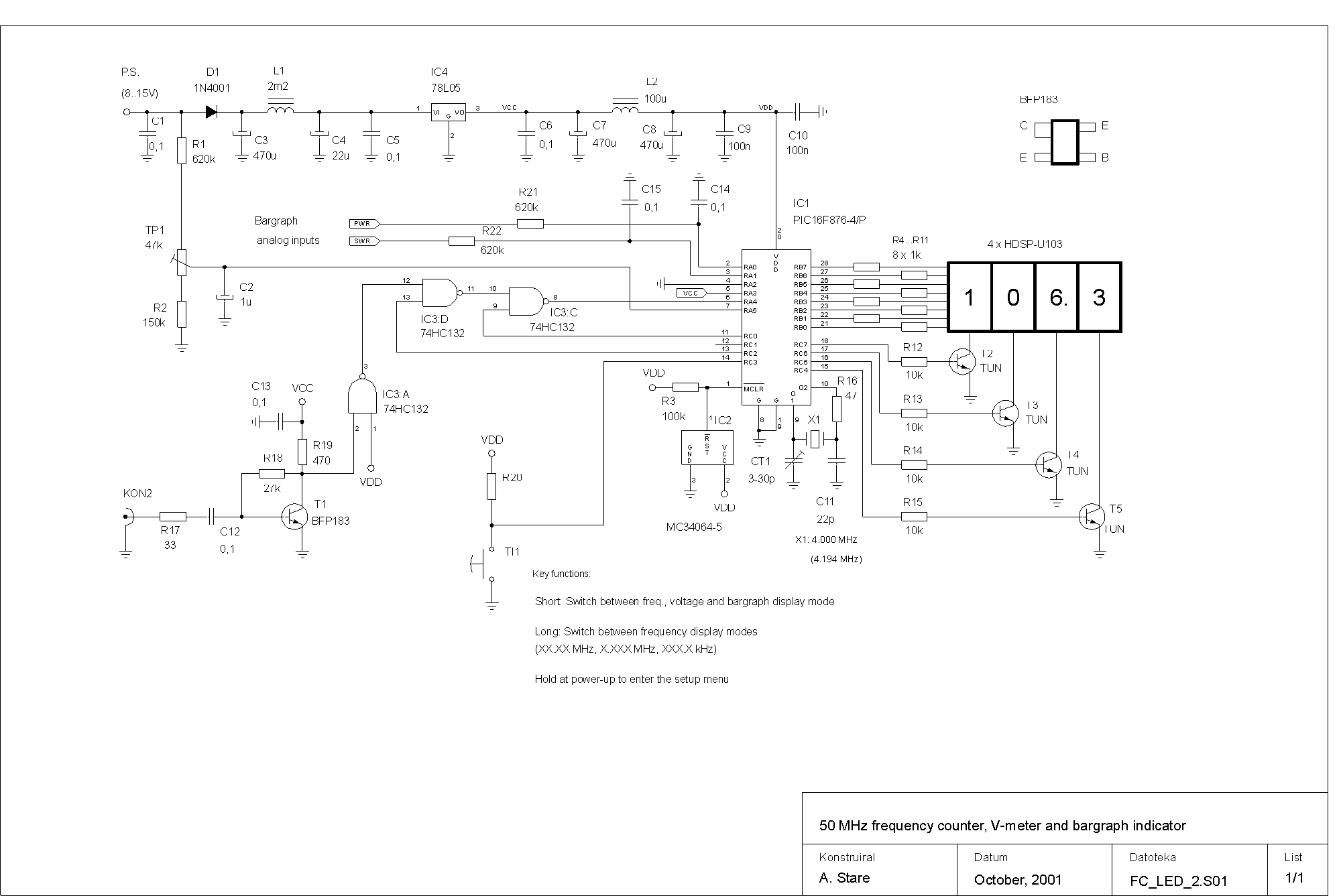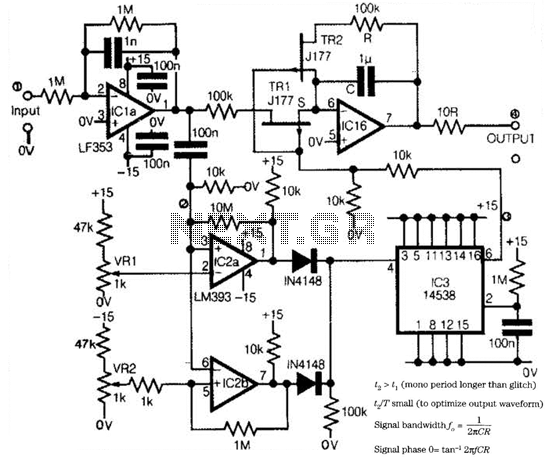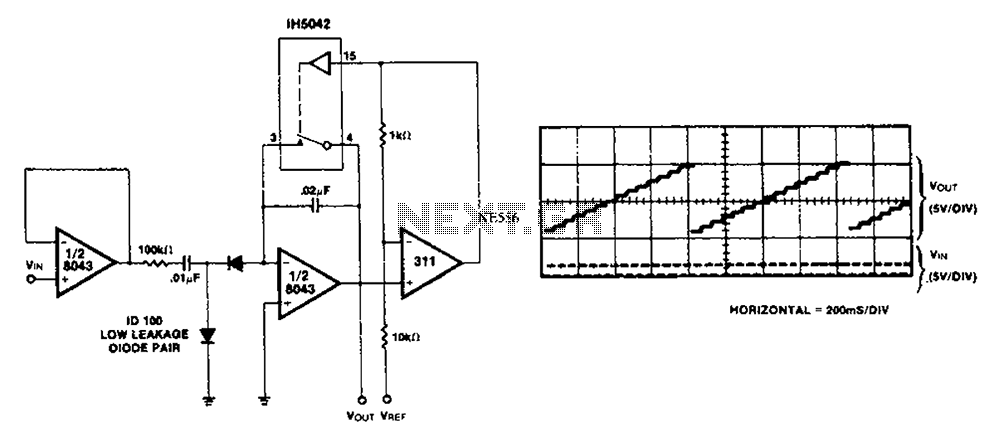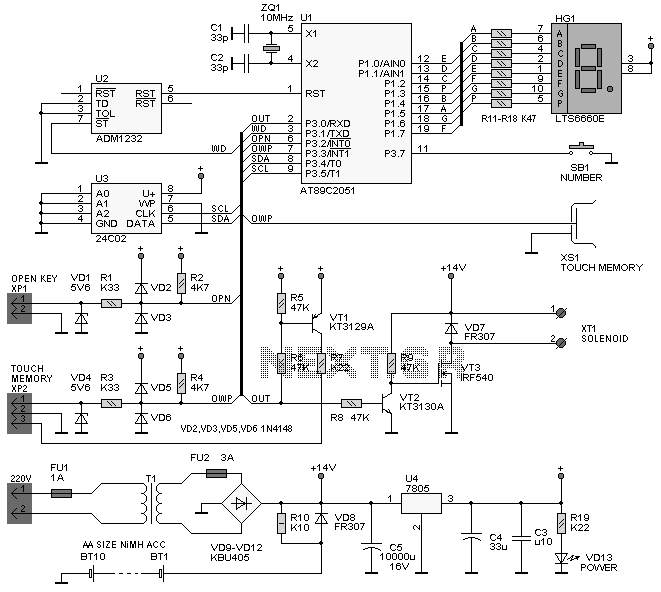
Analog Equaliser
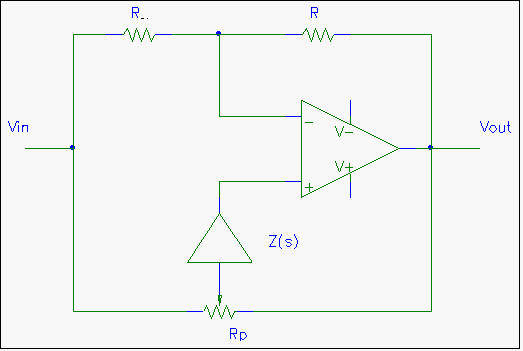
The time constant of R1C1 determines the low cutoff frequency, while the time constant of R2C2 determines the high cutoff frequency. The pass-band gain, Avpass = R2/R1. For a high-pass filter, Za must be capacitors and Zb resistors. By substituting Za = 1/sC and Zb = R into the above equation, the following equation is obtained: For a low-pass filter, Za must be resistors and Zb capacitors. By substituting Za = R and Zb = 1/sC into the above equation, the following equation is obtained: The optimal choice for the Q-factor is 0.707, resulting in the sharpest curve without any overshoot. If this Q-factor is selected, the value of K must be 1.586, which is also the pass-band gain. The signal should be attenuated if a constant signal level is desired. If a slope steeper than 12 dB/oct is desired, a higher-order filter can be used. The Butterworth response is preferred for audio applications due to its flat response. The simplest type of equalizer is the low and high shelving equalizers, commonly referred to as Bass and Treble on Hi-fi sets. The basic topology for such an equalizer involves a potentiometer, Rp, which sets the boost/cut ratio. The impedance of Z(s) must be high at the frequencies to boost/cut and low at other frequencies, effectively shorting out Rp. A capacitor substituted for Z(s) realizes a low shelving equalizer, while an inductor is needed for a high shelving equalizer. A combined low and high shelving equalizer circuit is commonly used in Hi-fi sets and mixing consoles. At high frequencies, Rbass is shorted out by C1, while C2 is inserted in place of the inductor in parallel with Rtreble. As frequency increases, the impedance of C2 decreases, prioritizing the gain setting on Rtreble over the unity gain network formed by the low section. The basic circuit for a graphical equalizer shows that the frequency-dependent impedance, Z(s), determines the center frequency of the equalizer. Z(s) must be low at the center frequency and high at other frequencies. By replacing Z(s) with a short, it is evident that the left part of Rp forms an attenuator feeding the input signal to the non-inverting operational amplifier, with gain controlled by the right half of Rp. If Z(s) is replaced with an open circuit, Rp connects only between the two input terminals of the op-amp, which are at the same potential, and Rp does not affect the circuit. Multiple bands can be implemented by placing more than one potentiometer in parallel, each with its wiper connected to a different Z(s) circuit. If b < 0.5, meaning Rp's wiper is moved left, the gain is below unity; conversely, if b > 0.5, the gain is above unity. The maximum boost/cut ratio is controlled by the impedance of Z(s), which limits the value of b to a < b < (1 - a), where a = Zpass/Rp. A practical circuit for Z(s) is illustrated with a classic series RLC circuit on the left and a gyrator replacing the inductor on the right. The analysis assumes the impedance of C1 and R1 is much higher than that of C2 and R2. A shelving equalizer can also be realized with this topology, where a low shelving equalizer uses a single capacitor in series with a resistor, while a high shelving equalizer retains the circuit configuration but has the high-frequency roll-off above the audio spectrum. This design prevents the circuits from boosting unwanted noise beyond the audio range. A parametric equalizer circuit, commonly used in older mixing consoles, is also shown.
The described circuit configurations are fundamental in audio signal processing, particularly in equalizers and filters. The time constants associated with R1C1 and R2C2 are critical in defining the bandwidth and frequency response of the filters. The Q-factor plays a significant role in determining the sharpness of the filter's response curve, with a value of 0.707 being a standard for achieving optimal performance without overshoot. The Butterworth response is particularly advantageous in audio applications due to its uniform gain across the passband, ensuring minimal distortion of the audio signal.
In practical applications, the low and high shelving equalizers allow for user-adjustable control over bass and treble frequencies, catering to personal preferences in audio playback. The use of potentiometers in the design facilitates a smooth transition in gain adjustments. The graphical equalizer expands on this concept by enabling multiple frequency bands to be adjusted independently, enhancing the versatility of the audio processing capabilities.
The implementation of various circuit topologies, including the use of gyrators, showcases the flexibility of the design approach, allowing for compact and efficient equalizer circuits. The emphasis on impedance characteristics is crucial, as it dictates the effectiveness of the equalization process, ensuring that desired frequencies are enhanced while minimizing interference from undesired noise. Overall, these circuit designs exemplify the intricate balance between theoretical principles and practical applications in audio technology.The time constant of R1C1 determines the low-cutoff frequency while the time constant of R2C2 determines the high cutoff frequency. The pass-band gain, Avpass=R2/R1. For a low-cut filter, that is a high-pass filter, Za must be capacitors and Zb resistors. By substituting Za=1/sC and Zb=R into above equation, the following equation is obtained: For a high-cut filter, that is a low-pass filter, Za must be resistors and Zb capacitors. By substituting Za=R and Zb=1/sC into above equation, the following equation is obtained: The best choice for the Q-factor is 0. 707. This results in the sharpest curve, without any overshoot. If this Q-factor is selected, the value of K must be 1. 586. Note that this is also the pass-band gain. The signal should therefore be attenuated if constant signal level is desired. If a slope steeper than 12db/oct is desired, a higher order filter can be used. It is best to use the Butterworth response for audio, because of its flat response. The simplest type of equaliser is the low and high shelving equalisers. This is usually called Bass and Treble on Hi-fi sets. Figure 3 shows the basic topology for such an equaliser. The potentiometer, Rp, sets the boost cut ratio. The impedance of Z(s) must be high at the frequencies to boost/cut and low at other frequencies, effectively shorting out Rp.
If a capacitor is substituted for Z(s), a low shelving equaliser is realised, while an inductor is needed for a high shelving equaliser. Figure 4 shows a circuit for a combined Lo and Hi shelving equaliser as used in conventional hi-fi sets and mixing consoles.
As can be seen, the inductor in parallel with Rtreble is omitted, C2 is instead inserted. At the high frequencies, Rbass is shorted out by C1. The higher the frequency becomes, the lower C2 s impedance become, giving the gain setting on Rtreble higher priority over the unity gain network formed by the lo section. The circuit in Figure 5 shows the basic circuit for a graphical equaliser. The frequency dependant impedance, Z(s), determines the centre frequency of the equaliser. The impedance of Z(s) must be low at the centre frequency, while high at other frequencies. By replacing Z(s) by a short it can be easily seen that the left part of Rp forms an attenuator feeding the input signal to the non-inverting operational amplifier, which gain is controlled by the right half of Rp.
If Z(s) is replaced by an open-circuit, Rp is only connected between the two input terminals of the op-amp, which is at the same potential and Rp does not effect the circuit. Multiple bands can be implemented by placing more than one pot in parallel, each with its wiper connected to a different Z(s) circuit.
It can be seen that if b<0. 5, that is Rp s wiper is moved toward the left, the gain is below unity, while if b>0. 5, that is Rp s wiper is moved toward the right, the gain is above unity. The maximum boost/cut ratio is controlled by the impedance of Z(s), which effectively limits the value of b so that a
To simplify the analysis of the circuit on the right, it is assumed that the impedance of C1, R1 is much higher than the impedance of C2, R2. A shelving equaliser can also be realised with this circuit topology. For a Lo shelving equaliser the circuit in Figure 6 can be replaced by a single capacitor in series with an resistor.
For a Hi shelving equaliser, the circuit in Figure 6 is used as it is, except that the high frequency roll-off of the impedance is above the audio spectrum. The same scheme can also be used for a Lo shelving equaliser. The advantage of this is that the circuits would not boost any unwanted noise beyond the audio spectrum.
Figure 7 shows a parametric equaliser circuit which is used in most older mixing c 🔗 External reference
The described circuit configurations are fundamental in audio signal processing, particularly in equalizers and filters. The time constants associated with R1C1 and R2C2 are critical in defining the bandwidth and frequency response of the filters. The Q-factor plays a significant role in determining the sharpness of the filter's response curve, with a value of 0.707 being a standard for achieving optimal performance without overshoot. The Butterworth response is particularly advantageous in audio applications due to its uniform gain across the passband, ensuring minimal distortion of the audio signal.
In practical applications, the low and high shelving equalizers allow for user-adjustable control over bass and treble frequencies, catering to personal preferences in audio playback. The use of potentiometers in the design facilitates a smooth transition in gain adjustments. The graphical equalizer expands on this concept by enabling multiple frequency bands to be adjusted independently, enhancing the versatility of the audio processing capabilities.
The implementation of various circuit topologies, including the use of gyrators, showcases the flexibility of the design approach, allowing for compact and efficient equalizer circuits. The emphasis on impedance characteristics is crucial, as it dictates the effectiveness of the equalization process, ensuring that desired frequencies are enhanced while minimizing interference from undesired noise. Overall, these circuit designs exemplify the intricate balance between theoretical principles and practical applications in audio technology.The time constant of R1C1 determines the low-cutoff frequency while the time constant of R2C2 determines the high cutoff frequency. The pass-band gain, Avpass=R2/R1. For a low-cut filter, that is a high-pass filter, Za must be capacitors and Zb resistors. By substituting Za=1/sC and Zb=R into above equation, the following equation is obtained: For a high-cut filter, that is a low-pass filter, Za must be resistors and Zb capacitors. By substituting Za=R and Zb=1/sC into above equation, the following equation is obtained: The best choice for the Q-factor is 0. 707. This results in the sharpest curve, without any overshoot. If this Q-factor is selected, the value of K must be 1. 586. Note that this is also the pass-band gain. The signal should therefore be attenuated if constant signal level is desired. If a slope steeper than 12db/oct is desired, a higher order filter can be used. It is best to use the Butterworth response for audio, because of its flat response. The simplest type of equaliser is the low and high shelving equalisers. This is usually called Bass and Treble on Hi-fi sets. Figure 3 shows the basic topology for such an equaliser. The potentiometer, Rp, sets the boost cut ratio. The impedance of Z(s) must be high at the frequencies to boost/cut and low at other frequencies, effectively shorting out Rp.
If a capacitor is substituted for Z(s), a low shelving equaliser is realised, while an inductor is needed for a high shelving equaliser. Figure 4 shows a circuit for a combined Lo and Hi shelving equaliser as used in conventional hi-fi sets and mixing consoles.
As can be seen, the inductor in parallel with Rtreble is omitted, C2 is instead inserted. At the high frequencies, Rbass is shorted out by C1. The higher the frequency becomes, the lower C2 s impedance become, giving the gain setting on Rtreble higher priority over the unity gain network formed by the lo section. The circuit in Figure 5 shows the basic circuit for a graphical equaliser. The frequency dependant impedance, Z(s), determines the centre frequency of the equaliser. The impedance of Z(s) must be low at the centre frequency, while high at other frequencies. By replacing Z(s) by a short it can be easily seen that the left part of Rp forms an attenuator feeding the input signal to the non-inverting operational amplifier, which gain is controlled by the right half of Rp.
If Z(s) is replaced by an open-circuit, Rp is only connected between the two input terminals of the op-amp, which is at the same potential and Rp does not effect the circuit. Multiple bands can be implemented by placing more than one pot in parallel, each with its wiper connected to a different Z(s) circuit.
It can be seen that if b<0. 5, that is Rp s wiper is moved toward the left, the gain is below unity, while if b>0. 5, that is Rp s wiper is moved toward the right, the gain is above unity. The maximum boost/cut ratio is controlled by the impedance of Z(s), which effectively limits the value of b so that a
To simplify the analysis of the circuit on the right, it is assumed that the impedance of C1, R1 is much higher than the impedance of C2, R2. A shelving equaliser can also be realised with this circuit topology. For a Lo shelving equaliser the circuit in Figure 6 can be replaced by a single capacitor in series with an resistor.
For a Hi shelving equaliser, the circuit in Figure 6 is used as it is, except that the high frequency roll-off of the impedance is above the audio spectrum. The same scheme can also be used for a Lo shelving equaliser. The advantage of this is that the circuits would not boost any unwanted noise beyond the audio spectrum.
Figure 7 shows a parametric equaliser circuit which is used in most older mixing c 🔗 External reference
